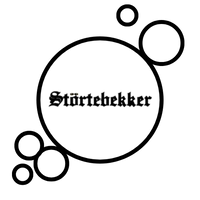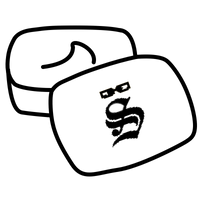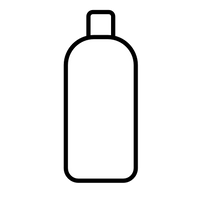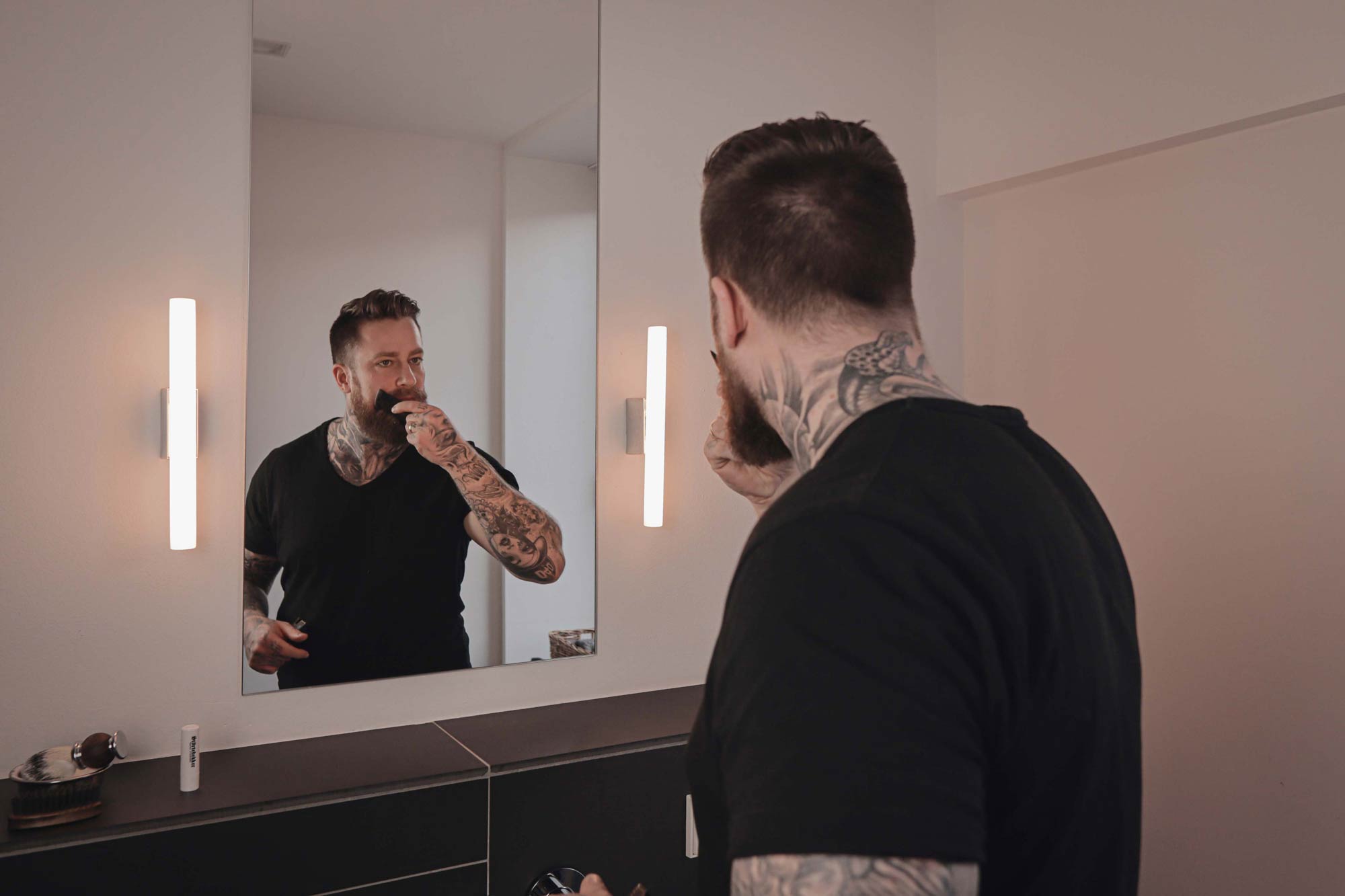Martin is a dedicated entrepreneur and passionate barbershop visitor. He has delved deeply into the world of shaving and beard care and wants to bring the unique barbershop experience to every bathroom.
The feeling is somewhere between “I wish it were different” and a catastrophe: The skin under the beard is inflamed and shows through the hair, dry and red.
Beard ringworm on the face can visually impact you quite significantly, depending on its severity.
But is the scaly, red skin in the beard just a visual nuisance, or is beard ringworm a disease? Is it beard fungus? Let’s clarify.

What Is Beard Ringworm?
Actually, beard ringworm, medically also known as Tinea barbae or beard mycosis, is a skin disease. It is caused by a fungus and occurs exclusively in men.
Its visual characteristics are:
- reddish,
- round,
- scaly patches.
Expert Tip: We have developed amazing beard products and put together an anti-itch set for you.
In many cases, the fungal infection heals on its own. In all other cases, the condition can be effectively treated with an antifungal medication or antimycotic.
What Causes Beard Ringworm?
The cause of beard ringworm in men is the so-called dermatophytes, or thread fungi. There are various subspecies of these fungi.
Two of these, Trichophyton mentagrophytes and Trichophyton verrucosum, are transmitted by rodents and cattle.
This type of beard ringworm, therefore, occurs predominantly in rural areas. Those affected need only have brief contact with an infected animal and then stroke their beard with their hand.
Other types of beard fungal infections are transmitted from person to person.
In general, all forms of thread fungi are highly contagious and resistant to environmental factors. They remain infectious even after years.
What Does Beard Ringworm Look Like?
Beard ringworm is characterized by red, scaly, and itchy round patches under the skin. It does not matter whether the infected person has a full beard, a stubble beard, or is even shaved.
Despite its name “beard ringworm,” it is an independent skin disease that occurs regardless of the presence of a beard.
Typical Symptoms of Beard Ringworm
Here is an overview of the most common symptoms of beard ringworm:
- Red, scaly, round spots under the beard.
- The spots may ooze partially.
- The affected skin area itches.
- The spots may further develop into pustules and small pus-filled bumps under the beard.
- If the nodules and bumps reach a certain size, an abscess may even form.

Diagnosis and Course of Tinea Barbae
The sooner beard ringworm is treated, the better and faster it heals. If you notice red, itchy areas on your face, it is worth seeing a dermatologist as soon as possible.
The doctor usually takes a swab to examine in the lab to determine the exact type of skin fungus. Treatment often involves prescribing an antifungal medication.
Treating Beard Ringworm: Home Remedies and Creams
Depending on the severity of the infection, various treatments for beard ringworm are available. In addition to medications prescribed by a doctor, there are also various home remedy tips for treating beard ringworm on your own.
Warning: We are not providing a guide to treating beard ringworm here but only offering some pointers. Our article does not replace a visit to the doctor.
Generally, we recommend that you preferably visit a dermatologist promptly before attempting self-treatment.
1. Tea Tree Oil
Tea tree oil has antimicrobial, antifungal, and antiviral properties. However, it is relatively strong and can cause skin irritation. If you want to try it, it is best to mix it with a neutral oil, such as almond or jojoba oil, and apply it cautiously with a cotton pad.
If your skin still reacts with irritation, it is better to discontinue use.
Make sure to use Australian tea tree oil. New Zealand tea tree oil is not suitable for skin conditions.
2. Aloe Vera
Aloe Vera is used to treat all kinds of skin conditions.
It is advisable to apply the pure juice of the plant overnight directly to the affected skin areas. This should immediately soothe the skin and relieve itching. After a few days, an initial improvement should be noticeable.
Feel free to browse our Störtebekker Shop. We have put together a great shaving & beard care set that you can use after healing from beard ringworm.
3. Antimycotics
Those who have their beard ringworm treated by a doctor will receive what are known as antimycotics.
The first step is usually an antimycotic cream or ointment to be applied to the affected areas. It kills the fungus and allows the skin to heal.
For more severe cases, antimycotics are also available for oral administration. If the beard ringworm is recognized too late or is already advanced, the doctor will prescribe it.
4. Schüssler Salts
Ointments and creams with Schüssler salts can also be an effective treatment option for beard ringworm.
The potent mineral salts in them can boost the skin’s healing process. Especially:
- Salt No. 1, “Calcium fluoratum” relieves itching and rash.
- Also, salt No. 11, “Silicea”
- And No. 12, “Calcium sulfuricum” have proven effective for improving cracked, diseased skin.
Preventing Beard Ringworm
Preventing beard ringworm is even better than treating it.
Prevention is best achieved through a regular and good grooming routine:
- Wash your face daily and your beard at least every two days with beard shampoo.
- Prepare your skin for shaving - soften the beard hairs with a shaving soap.
- Shave in the direction of hair growth and clean the blades with warm water after shaving.
- Change the blades regularly and do not share your razor with others.
- Care for the beard area after shaving with an aftershave, a beard balm, and additionally a beard oil.
This keeps the skin well-groomed and resilient. Use products without chemical additives, as these can cause allergies and further irritate the skin. We recommend the beard oil from Störtebekker. It contains high-quality, purely natural oils.
For tips on how to wash your beard properly, read this article. If you want to dive deeper into the topic, don’t miss the article on optimal beard care.
Conclusion
If you suffer from beard ringworm, you should take it easy with your beard styling.
Shave less frequently during the treatment period and let your skin rest. Effective antifungal creams usually show results fairly quickly - still, don’t stop treatment too early to prevent the ringworm from coming back.
Often, beard ringworm is not a shaving mistake - take it seriously, as it is a skin disease!
What experiences have you had with beard ringworm? What has helped you?
Further Questions on Beard Ringworm
Is Beard Ringworm Contagious?
Beard ringworm is unfortunately highly contagious. The fungi are very resilient and can be transmitted from skin to skin or from animals to humans.
The thread fungi particularly thrive in damp, warm environments like showers, saunas, or gyms. So pay extra attention to your hygiene in these places.
Is Beard Ringworm Dangerous?
Although beard ringworm itself is not particularly dangerous, it can quickly become unpleasant. Additionally, the beard fungus affects your appearance, making many beard wearers feel self-conscious and trying to cover up the redness.
Want more beard care tips? Then check out these articles:
 Free shipping from
79 CHF
Free shipping from
79 CHF
 100 days return
100 days return
 Festes Shampoo
Festes Shampoo Body Bar
Body Bar Handsoap
Handsoap Pomade
Pomade Gesichtspflege
Gesichtspflege Deo
Deo Hair & Body Wash
Hair & Body Wash Haar Booster
Haar Booster Safety razor
Safety razor Straight razor
Straight razor Shaving soap
Shaving soap Razor blades
Razor blades Shaving accessories
Shaving accessories Beard care
Beard care Beard styling
Beard styling




















